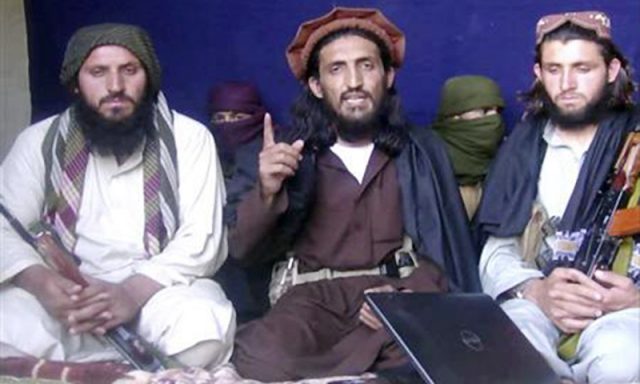
Pakistan’s Jamaat-ul-Ahrar: A Violent Domestic Threat
Publication: Terrorism Monitor Volume: 14 Issue: 18
By:

Jamaat-ul-Ahrar (JuA), once a disgruntled breakaway faction of Tehrik-e-Taliban Pakistan (TTP), has been behind a series of deadly attacks across Pakistan since March 2016, apparently contradicting the Pakistani Army’s claim to have eliminated terrorism from North Waziristan and the Khyber Agency through years of its counter-terrorism operation Zarb-e-Azb (Daily Times, September 01).
Led by Omar Khalid Khorasani (a.k.a. Abdul Wali), a firebrand Taliban commander from Mohamand agency, JuA has been behind at least six major terrorist incidents this year, primarily targeting minorities, Christians in particular, and in August was named a specially designated global terrorist (SDGT) group by the United States.
Khorasani has in the past called for the establishment of a global caliphate and expressed the intention of seizing Pakistan’s nuclear arsenal in order to defend Islam. While he has more recently disavowed some of his group’s more international pretensions, JuA’s many grisly strikes on Pakistani soil have brought immense notoriety to the group of late.
Relationship with the Taliban
The long suppressed leadership rift within the Pakistani Taliban’s rank and file was brought into the open in late August 2014, when TTP leader Mullah Fazlullah banished Khorasani from the organization, accusing him of conspiracy against Mullah Omar, then the Taliban leader. He also exposed Khorasani’s secret ties with other disgruntled sectarian Taliban leaders and groups such as Junud-al-Hafsa and Ahrar ul Hind, and that he had formed a group under the JuA’s hybrid Jihadi banner (Dawn, September 7, 2014).
Reports suggested that the discord began when Khorasani was overlooked for TTP’s top post and sidelined following the death of Hakimullah Mehsud in November 2013, in favor of Mullah Fazalullah, who was eventually given the post of Taliban leader in Pakistan.
Before the JuA was established, Omar Khalid Khorasani and other Taliban commanders led Ahrar-ul-Hind, a TTP splinter group that envisaged consolidating the entire Indian subcontinent under Taliban rule, and carried out suicide bombings in Quetta and Peshawar in March 2014 in which 19 people were killed (Express Tribune, March 15, 2014).
However, in March 2015, less than a year after its split with the TTP, JuA realigned itself into the larger Taliban conglomerate and joined with TTP-Fazllulah and another Taliban splinter group, Lashkar-e-Islam, purportedly to put up a united front against the Pakistani military’s Operation Zarb-e-Azb.
Even in brief period after its split from the TTP, Khorasani retained the name of the TTP as prefix to the Jamaat-ul-Ahrar (TTP-JuA). The leadership of JuA claimed in the Taliban magazine Ihyae Khilafat, that TTP-JuA had come into being as result of a “restructuring” of the Pakistani Mujahideen, though it failed to mention the falling out with Mullah Fazllulah in transparent terms. It also reiterated the existing ideological differences between JuA and other militant organizations in Pakistan.
Recent JuA Operations
The latest JuA attack took place on September 2, when a suicide strike targeted lawyers and security personnel at a court in Mardan District in Khyber Pukhtunkhwa province, killing 13 people and injuring over 40 others (Dawn [Karachi], September 2; Geo TV News, September 2). Earlier in the day, JuA militants had targeted a Christian dominated neighborhood in Peshawar, triggering a gun battle between the security forces that left one member of the minority Christian community and four attackers dead (Dawn, September 2).
Similar attacks targeting lawyers took place in Quetta on August 8, killing 75 people, including 55 lawyers, when hundreds of lawyers and journalists had gathered at the Civil Hospital to mourn the killing of Balochistan Bar Association President Bilal Anwar Kasi (Daily Pakistan, August 8; Express Tribune, August 8). Kasi had been assassinated earlier in the day near Manno Jan road, Quetta city. JuA spokesman Ehsanullah Ehsan claimed responsibility for the Quetta hospital attack and threatened further violence “until the imposition of an Islamic system in Pakistan.”
March 2016, however, remains JuA’s most violent month, with three major attacks, starting with the March 7 Court Complex attack in Charsadda’s Shabqadar area, which killed nearly 17 people (Dawn, March 7). The Charsadda attack was executed to avenge the death of Mumtaz Qadri, who was convicted of killing former Punjab governor Salman Taseer in January 2011.
In late March, JuA targeted the Gulshan-e-Iqbal amusement park in Lahore during Easter day celebrations, killing more than 70 people including women and children. The attack was targeted at the minority Christian community celebrating Easter at the park. JuA spokesman Ehsan called the attack a message for the Pakistani Prime Minister Nawaz Sharif. In an Urdu-language statement he said: “We want to send this message to [the] Prime Minister … that we have entered Lahore. He can do what he wants but he won’t be able to stop us. Our suicide bombers will continue these attacks” (The Nation, March 27).
Targeting Minorities
The Gulshan-e-Iqbal attack was not the only time JuA targeted Christians in Lahore. In mid-March 2015, the group bombed a number of churches in the Youhanabad town of Lahore, killing about 14 people and injuring many more during Sunday service (Express Tribune, March 15, 2015).
Beyond the vulnerable Christian minorities and the law practitioners in Lahore, JuA militants have also targeted education centers. The death and devastation at the Gulshan-e-Iqbal Park in Lahore was reminiscent of December 2014 Peshawar School attack, also perpetrated by the JuA, in which over 150 people, largely school children, lost their lives. Khorasani claimed responsibility for the devastating attack on the army private school, describing it as revenge for Operation Zarb-e-Azb’s activities in the tribal areas (Express Tribune, December 21, 2014). He said in a statement: “We targeted the school because the Army targets our families. We want them to feel our pain” (iTV News, December 16, 2014).
Support for Transnational Groups
When Khorasani started to organize JuA under his leadership, he had the support of other Taliban commanders, primarily from Pakistan’s Orakzai agency, Bajour agency and his own Mohmand agency. Many senior Taliban commanders, including the founders of the TTP, such as Moulana Qasim Khorasani and Moulvi Omar, have joined the ranks of JuA. Other commanders who have joined the JuA are Qari Shakeel Haqqani (Charsadda), Maulana Yasin (Swat), Mufti Mishbah (Peshawar) and Qari Ismail (Khyber) (Pakistan Today, August 26, 2014).
JuA’s leaders have vowed to defeat the Pakistani army because it obstructs the implementation of sharia in Pakistan. JuA also, somewhat ambitiously, has designs on Kashmir and even beyond. In October 2014 Khorasani, along with his cohorts, even released a video urging al-Qaeda’s Jabhat al Nusra in Syria and Islamic State (IS) to reconcile with each other and proposing that he could mediate between the warring jihadi groups in Syria. [1] This posturing of JuA’s leadership was likely aimed at drawing the attention of IS or al-Qaeda and enhancing its stature within the domestic jihadi landscape.
The designation by the United States in early August of JuA as a global terrorist group – a move that allows for sanctions against the group and its members – prompted Khorasani to openly criticize the United States and deny any ties with transnational jihadi groups.
Irrespective of his denials, JuA leaders have openly supported the transnational jihadi ideals that both al-Qaeda and IS have espoused. The group also proved its resilience in the face of a number of military offensives in the past, and its recent actions indicate it has survived the ongoing operations of the Pakistani army, something that augers poorly for Pakistan.
NOTES
[1] Video available (in Arabic): https://archive.org/details/IhyaeMasalihat




